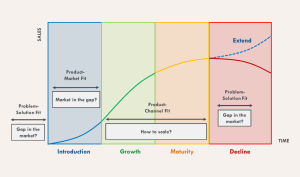In the second of this three-part series on product growth engine for innovation and business growth, we explore product-market fit and the product life cycle.
The biggest goal of a product manager who is building a digital product is to achieve product-market fit. Product-Market Fit is a concept that came about from the start-up world. It is widely attributed to Marc Andreesen, although the term was actually coined by Andy Rachleff, the co-founder of Benchmark Capital and Wealthfront, in explaining the most important goal of a startup.
In his “The Only Thing that Matters” blog, Marc Andreesen explained why he also thinks that for a start-up the only thing that matters is product-market fit, which he further explains as being in a good market with a product that can satisfy that market. This definition offers two conditions for it to stand. First, the market problem must be sizeable in order for the market to be good.
Second, the product (aka solution) must also address the market problem satisfactorily. And because a product has a life cycle, product-market fit can be defined as a point in time during the life cycle at which the market responds so well to the product that the product fits the market’s needs. To the product manager, this is like the proverbial pot of gold at the end of the rainbow.
The product life cycle is defined by the stages through which it undergoes from ideation to development, launch, decline, and eventually exit. All products go through four stages of the product life cycle: Introduction, Growth, Maturity and Decline.
The Introduction stage is when customers are first introduced to the new product. The Growth stage is when the product becomes more attractive and is increasingly adopted by a growing customer base. The product then enters the Maturity stage as the market becomes more saturated with both the product as well as alternatives by competitors. Eventually, it goes into the Decline stage as its market share dwindles due to competition. Most businesses will try to extend the product’s life during this stage by pivoting it or moving to adjacent markets.


